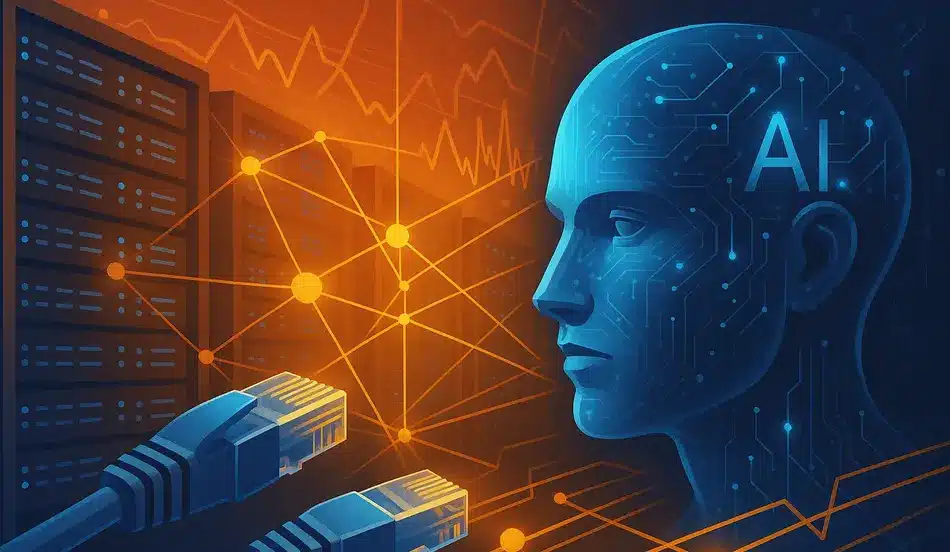Why the internet wasn’t ready for AI – this is something most people haven’t considered, but the internet we’re all using right now was actually built decades ago when the heaviest thing people did online was sending emails or maybe downloading a song on Napster. Today, AI workloads are exploding everywhere, from cloud apps running payroll systems to factory robots to video calls, and the networks – the invisible plumbing that makes all of this work – are crumbling underneath the pressure.
The internet was designed for a completely different era, when bandwidth requirements were minimal and latency wasn’t critical. Today, AI applications demand massive data transfers, real-time processing, and 99.99% reliability. This fundamental mismatch has created a hidden infrastructure crisis that’s affecting businesses, developers, and end users across every industry.
The problem isn’t just technical – it’s economic. When networks can’t handle AI workloads, businesses lose millions in downtime, productivity plummets, and innovation gets bottlenecked. The solution requires a complete reimagining of how we build and manage network infrastructure for the AI era.
The Bandwidth Explosion: AI’s Insatiable Data Hunger
AI workloads have fundamentally different bandwidth requirements than anything the internet was originally designed to handle. Training AI models means moving terabytes, sometimes petabytes of data across networks. Even running these models – what’s called inference – involves constant streaming of video, voice, and text data that would have been unimaginable when the internet was first built.
The scale is staggering. A single AI training session can require more bandwidth than an entire data center used just a few years ago. When you consider that 74% of companies are now using AI in at least one function and 90% of enterprises are in the cloud, this isn’t a niche problem anymore – it’s mainstream.
The internet’s original architecture simply wasn’t designed for this kind of data intensity. The protocols, routing algorithms, and physical infrastructure all assumed much lighter workloads. Today’s AI applications are pushing these systems to their absolute limits, creating bottlenecks that didn’t exist before.
The Latency Crisis: When Milliseconds Matter
AI applications are incredibly sensitive to network delays, creating a latency crisis that the original internet architecture never anticipated. Real-time speech translation, autonomous vehicles, and interactive AI assistants all require near-instantaneous responses. A few milliseconds of lag can mean the difference between success and failure.
This creates a fundamental problem because the internet was built for asynchronous communication – emails, web pages, file downloads. The concept of real-time, low-latency applications wasn’t part of the original design philosophy. Today’s AI applications need the kind of network performance that was previously only available in specialized, local networks.
The result is that many AI applications either don’t work reliably over the internet or require expensive, specialized network infrastructure that most businesses can’t afford. This limits AI adoption and creates a digital divide between organizations that can afford premium networking and those that can’t.
The Latency Crisis: When Milliseconds Matter
AI-driven industries are pushing the limits of today’s networks — where milliseconds can define success or failure. Employers at the forefront of AI, networking, and real-time applications need talent that thrives under pressure. Post your job on WhatJobs today and connect with professionals ready to solve the challenges of tomorrow’s digital world.
Post a Job Free for 30 Days →The Reliability Imperative: When Downtime Costs Millions
Cloud applications now run everything from payroll systems to factory robots, making network reliability absolutely critical. When your entire business depends on cloud infrastructure, downtime doesn’t just mean inconvenience – it can cost millions of dollars and stop operations completely.
The original internet was designed with the assumption that occasional outages were acceptable. Email could wait, web pages could be slow, and file downloads could be retried. But today’s AI-powered business applications require 99.99% uptime and sub-second response times.
This reliability requirement exposes the fundamental weakness of the internet’s original design. The protocols and infrastructure were built for resilience, not for the kind of mission-critical reliability that modern AI applications demand. When networks fail, entire businesses can grind to a halt.
The Hidden Infrastructure Problem: Networking as the Weakest Link
Networking has become the hidden infrastructure that makes AI possible, but it’s also the weakest link in the entire system. We spend so much time talking about exciting developments like GPUs, chips, and massive AI models, but none of that matters if the network can’t handle the load.
Think of networking like electricity – you don’t notice when it works, but the second it fails, everything else collapses. This hidden dependency means that network problems can bring down entire AI systems, even when the AI models themselves are working perfectly.
The problem is compounded by the fact that most businesses are stuck with patchwork networks – one vendor for Wi-Fi, another for firewalls, someone else for cellular. This creates a fragile, complex system that’s difficult to troubleshoot and maintain, especially under the pressure of AI workloads.
The Impact on Technical Roles: When Networks Break Everything
When networks aren’t built for AI, it shows up in the day-to-day work of technical professionals across every role. Network engineers find themselves stuck in “vendor hell” – managing five different dashboards, dealing with firmware updates that don’t align, and trying to stitch together security policies across systems that were never meant to work together.
Data scientists and machine learning engineers face bottlenecks when moving training data, delayed access to GPUs in the cloud, and timeouts when streaming large datasets. When you’re waiting hours or days for a training job to finish because the network can’t keep up, it’s a direct hit to productivity.
Site reliability engineers and DevOps teams feel the impact through unreliable CI/CD pipelines, monitoring systems, and logging. If the network layer isn’t reliable, the entire stack above it starts throwing alerts. You can’t achieve true high availability without networking that matches the resilience of your compute and storage.
Even security teams get squeezed by patchwork networks, which mean inconsistent firewalls, shadow IT, and overlapping policies. Instead of enforcing zero trust, they’re writing exceptions and workarounds just to keep things running.
The Business Impact: When AI Can’t Scale
The networking infrastructure crisis isn’t just a technical problem – it has real business consequences. When networks can’t handle AI workloads, businesses can’t scale their AI initiatives, limiting their ability to compete and innovate.
This creates a vicious cycle where businesses invest in AI technology but can’t fully utilize it because their network infrastructure can’t support it. The result is wasted investment, frustrated teams, and missed opportunities for growth and efficiency.
The problem is particularly acute for smaller businesses that can’t afford to build custom network infrastructure. They’re forced to choose between expensive, enterprise-grade networking solutions or accepting the limitations of their current infrastructure.
The Future We’re Missing: What AI Could Unlock
If we don’t modernize networking infrastructure, AI will stay limited to labs and test demos. But if we do, we unlock incredible possibilities: hospitals that never lose access to patient records, factories that can run 24/7 with no downtime, offices where cloud apps just work seamlessly, and smart cities where traffic lights, EV chargers, and emergency services are all connected reliably.
The invisible layer of networking is what decides how fast AI scales into every part of our lives. Without proper infrastructure, AI remains a promise rather than a reality. With it, AI becomes the transformative force it was always meant to be.
This isn’t just about faster internet – it’s about building the foundation for a completely different kind of digital economy, one where AI can operate at scale across every industry and application.
The Future We’re Missing: What AI Could Unlock
AI’s potential goes far beyond labs — from hospitals with uninterrupted care to factories that never stop running. But it takes the right people to build the infrastructure that makes it possible. Post your job on WhatJobs today and connect with innovators ready to create the digital economy of the future.
Post a Job Free for 30 Days →The Solution: Integrated, AI-Ready Networking
The solution requires a complete reimagining of how we build and manage network infrastructure. Instead of patchwork systems with multiple vendors and incompatible components, businesses need integrated solutions that handle wired, wireless, and cellular connectivity seamlessly.
This means working with partners who can deliver a complete networking stack – hardware, firmware, and software – all designed to work together and managed end-to-end. Instead of juggling five or six providers and hoping everything works together, businesses get one partner who can future-proof their infrastructure for AI workloads.
The key is building networks that scale, stay secure, and give engineers real control. This results in fast, secure, and scalable connectivity that just works, whether you’re running an office, a warehouse, or a huge data center.
Frequently Asked Questions
Why the internet wasn’t ready for AI?
Why the internet wasn’t ready for AI is because it was built decades ago for lightweight workloads like emails and web pages, not the massive data transfers, real-time processing, and 99.99% reliability that AI applications demand.
How do AI workloads differ from traditional internet traffic?
AI workloads differ from traditional internet traffic in their massive bandwidth requirements (terabytes to petabytes), real-time latency needs (milliseconds matter), and mission-critical reliability demands that the original internet architecture never anticipated.
What roles are most affected by inadequate network infrastructure for AI?
Roles most affected by inadequate network infrastructure for AI include network engineers stuck in vendor hell, data scientists facing data transfer bottlenecks, DevOps teams dealing with unreliable CI/CD pipelines, and security teams managing patchwork systems.
How does network infrastructure impact AI scalability?
Network infrastructure impacts AI scalability by creating bottlenecks that limit data transfer speeds, causing latency issues that break real-time applications, and creating reliability problems that prevent mission-critical AI systems from operating effectively.
A Real-World Example: The Manufacturing Company’s AI Nightmare
Sarah Martinez, IT Director at a mid-size manufacturing company, discovered the hard way why the internet wasn’t ready for AI. “We invested $2 million in an AI-powered quality control system that was supposed to revolutionize our production line,” she explains. “The AI models worked perfectly in testing, but when we tried to deploy them in production, everything fell apart.”
The problem wasn’t the AI technology itself – it was the network infrastructure. “Our quality control system needed to process high-resolution images in real-time and send results back to the production line within milliseconds,” Sarah says. “But our existing network couldn’t handle the bandwidth, and the latency was killing us.”
The company’s patchwork network – a mix of old Wi-Fi equipment, outdated switches, and incompatible security systems – created bottlenecks that made the AI system unusable. “We were getting timeouts, dropped connections, and delays that made the whole system unreliable,” Sarah explains. “The AI was making decisions based on stale data, which defeated the entire purpose.”
After six months of troubleshooting and $500,000 in additional network upgrades, Sarah’s team finally got the system working. “But by then, we’d lost confidence in the technology and our production team had reverted to manual processes,” she says. “The AI investment was essentially wasted because we didn’t have the network infrastructure to support it.”
Sarah’s story illustrates how the networking infrastructure crisis can turn promising AI investments into expensive failures. “The lesson is clear,” she says. “You can’t just bolt AI onto existing infrastructure. You need to build the network foundation first, or your AI initiatives will fail before they even get started.”
Don’t Let Network Infrastructure Kill Your AI Dreams
The networking infrastructure crisis is the hidden barrier preventing AI from reaching its full potential. While everyone focuses on algorithms and models, the real bottleneck is often the network that connects everything together.
Businesses must act now to modernize their network infrastructure before investing in AI. The cost of network upgrades is far less than the cost of failed AI initiatives, and the competitive advantage of having AI-ready infrastructure is enormous.
The future belongs to organizations that can scale AI across their entire operation. Don’t let inadequate networking infrastructure be the reason your AI initiatives fail.




